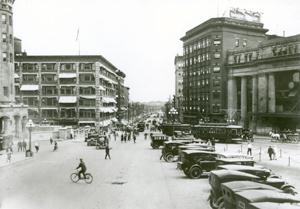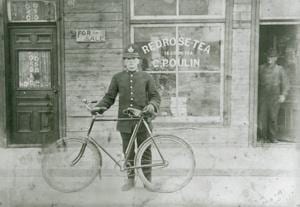
Rideau St and Union Station, 1926. Credit: City of Ottawa Archives
In the decades before Bank St became the main drag of Ottawa’s gay village, where was the centre of gay life in the city? A tourist guide published in 1899 inadvertently advertised the hub of homosexual activity in Ottawa: “over the bridges electric streetcars and bicycles fly in rapid succession, while the sidewalks on either side are gay with life and colour.” The guide directs our attention to the busy interzone between Wellington and Rideau streets.
If you were a man cruising for sex in early 20th-century Ottawa, the strip along Wellington to Rideau pulsed with sexual possibilities. This is confirmed by court transcripts of men charged with homosexual offences that reveal fascinating details about how and where men had sex in the city.
In the early 20th century, the fashionable area around Wellington and Sparks streets was known, according to our guide, as “the Broadway of Ottawa.” In December of 1916, Joseph P and Edward R hooked up on Wellington. After some initial conversation and furtive groping, the two men ducked around the corner. As the police constable who arrested them explained to the court, Edward told the officer that Joseph “took him there to suck him off.”
But it was the threshold where Wellington met Rideau St that promised the most pleasure. What made this area so popular? For one thing, as the site of the city’s main train station, first Union Depot and, after 1912, the grand Union Station, this was the point of entry for many travellers and transient men coming into Ottawa. As the tourist guide described it, Union Depot and its adjacent streets were filled with “the never-ending coming and going of travellers.” Men who had sex with other men in and around the train station had to be very careful; the Canadian National Railway had its own police. In 1934, Alfred B, a 24-year-old labourer, and his friend Douglas H learned this the hard way when they were arrested by Brenton H, “Special Agent, CNR.”
A number of nearby hotels served the many people arriving in the city at Union Station. Men interested in sex with other men took full advantage of the sexual space furnished by the hotels. Around the corner from the train station on Sussex Dr, for example, stood the Grand Central Hotel. As Joseph R told the court in June of 1921, “I slept with [the other man] last night at the Grand Central Hotel, corner of George and Sussex Sts. He invited me to sleep with him. He put my penis in his mouth and sucked me.”
Descending into Lowertown, many men found it possible to make casual pickups along Rideau St. In 1922, James D met Peter M “when I was coming out of the Princess Theatre,” located at 160 Rideau St. “He asked me where he could get a room,” James explained to the court. “I told him he could get a room on Rideau St. He walked along with me down Rideau. He said he would give me $2 and it would take only five minutes. When at the Rideau St Public School he took me around at the back of the school. It’s very dark there. He put me against the wall and put something between my legs.”
In addition to hotels and theatres, cheap, all-night diners and lunch counters were important social centres within urban homosexual subcultures. The Bowles chain of lunch counters turned up numerous times in court case files. In Ottawa, the principal Bowles Lunch was located at 30 Rideau St. In October of 1929, 17-year-old John M left his rural home and travelled to the big city “to see what it was like.” John arrived in Ottawa at 2am with no place to sleep. He headed for one of the few places open at such a late hour, the Bowles Lunch Counter.
It is unclear whether John knew in advance that Bowles was a popular homosexual haunt, but it was not long before he met someone. As John explained, “I went into Bowles Lunch near the Station on Rideau St.” There he met Moise B, a single, 29-year-old labourer. Sitting next to each other in their booth at Bowles, they talked until 6am and then left for Moise’s room “above his father’s shoemaking shop.” It was, according to John, “an ordinary room with a bed in one corner.
“We got undressed and went to bed. We were laying there a while and after a while” they had sex. It was to be the beginning of a relationship. John moved in with Moise and got a job at the Rideau Bowling Alley. According to John, they slept with each other every night, and for the next month or so they had sex “about four times a week.”
With so much of homosexual life necessarily focused on the street, men had to carve out private space in public places, including lavatories. Beginning in the late-19th century, the city erected lavatories to provide facilities for the many people who lacked indoor plumbing. It was in October of 1921 in the lavatory in the Byward Market that Frank B had sex with Vincent L. As Vincent told the court, “I saw Frank B yesterday afternoon at about 4:30. I met him in the market.” Men on the street employed a variety of visual cues to communicate their interest in one another. “He made signs to me to go into the lavatory,” Vincent explained. “He told me he wanted to jerk me off.” Sometimes words weren’t necessary. Once they were inside the lavatory stall, Frank “unbuttoned my clothes and put my person into his mouth. Nothing was said between us.” Despite their efforts to conceal their activities by remaining quiet, they were discovered by an Ottawa police constable. As the constable told the court, “I happened to pass there. I was suspicious and I returned and I saw them buttoning their trousers.”
Men took great risks when hooking up on city streets and in public places, especially the ever-present threat of getting caught by a police constable or another passerby. But even after being apprehended, men did not simply acquiesce. Frank, for example, tried several different strategies to resist arrest. As the constable explained, “I asked him his name and he gave me his name as Frank L.” Giving false names was a common tactic to avoid exposure. Even after getting caught with his pants down with another man in a public lavatory, Frank maintained his defiance. As the constable testified, “I insisted to know what took place [but] he replied he was not going to give me any particulars about this matter.”
Many of the tactics men used ultimately failed. Frank, for one, was convicted and sentenced to six months in the Ottawa jail. But if we focus solely on that outcome, we will miss what was really significant. Remember, these men were having sex and trying to outsmart the police decades before the emergence of a gay political movement. Men’s small, subversive acts represented a brave form of resistance to the policing of homosexual sex nearly a century ago.

 Why you can trust Xtra
Why you can trust Xtra


